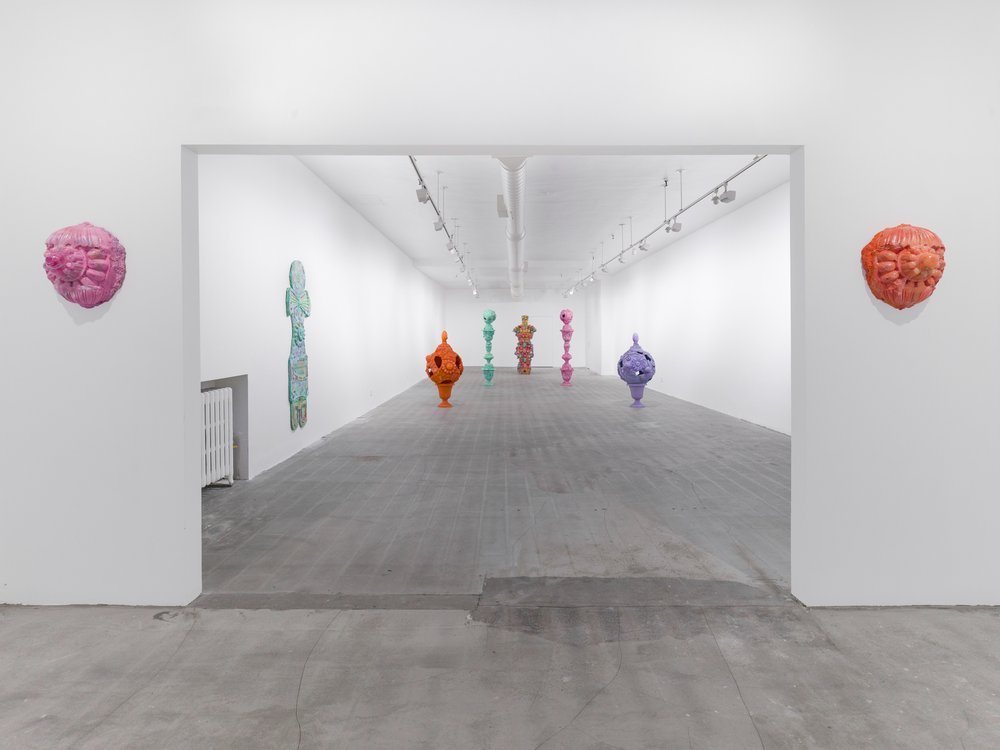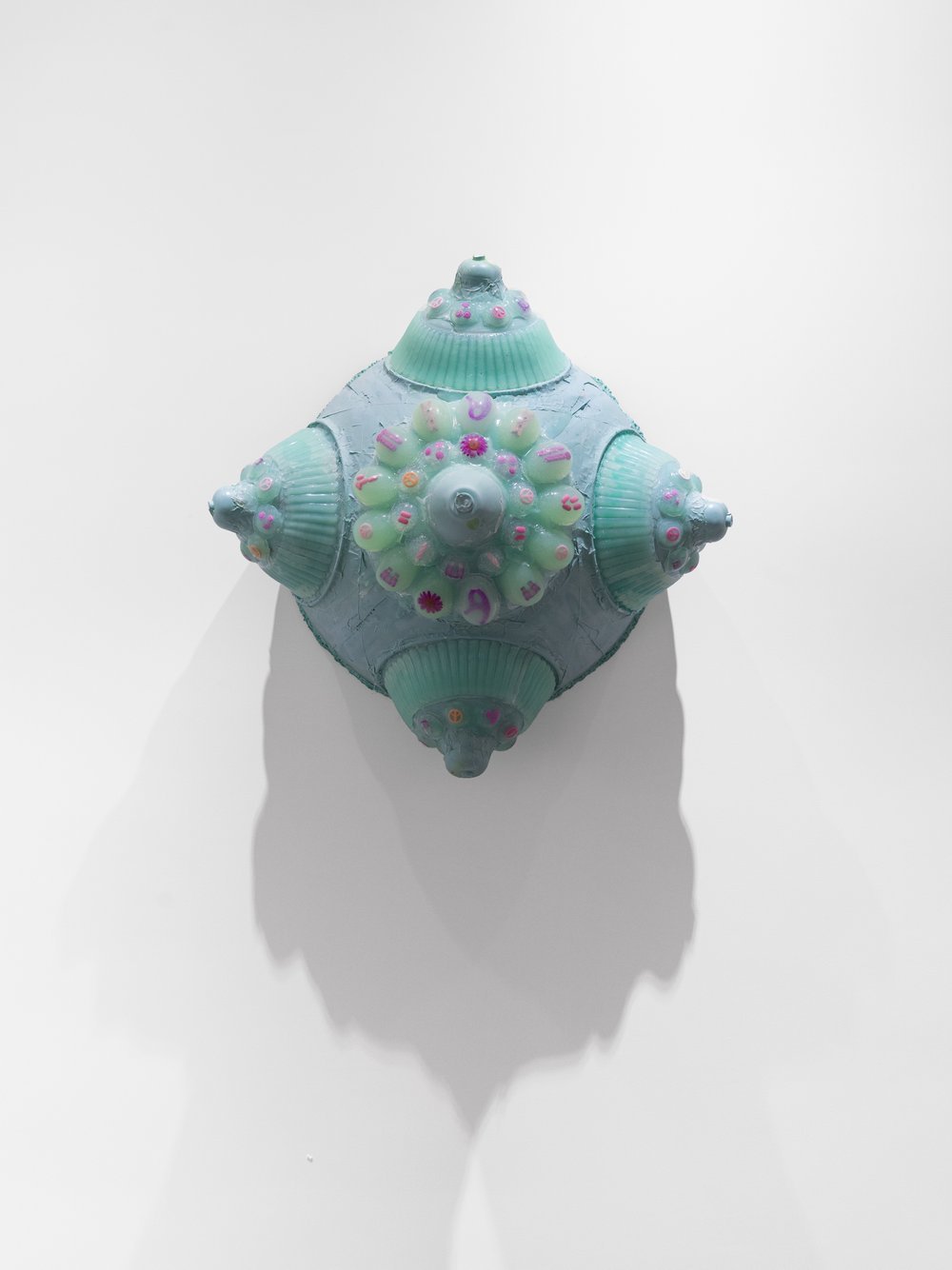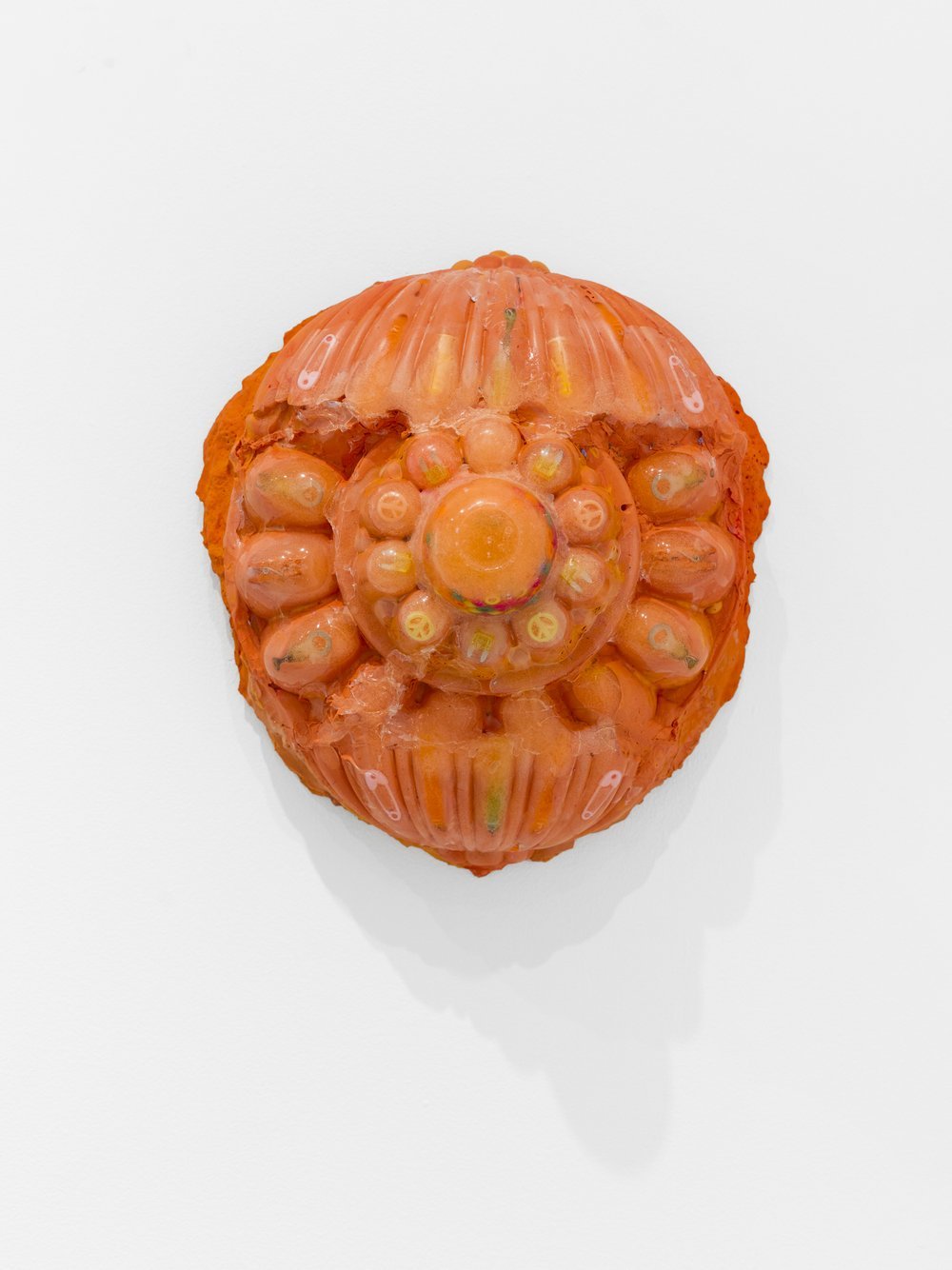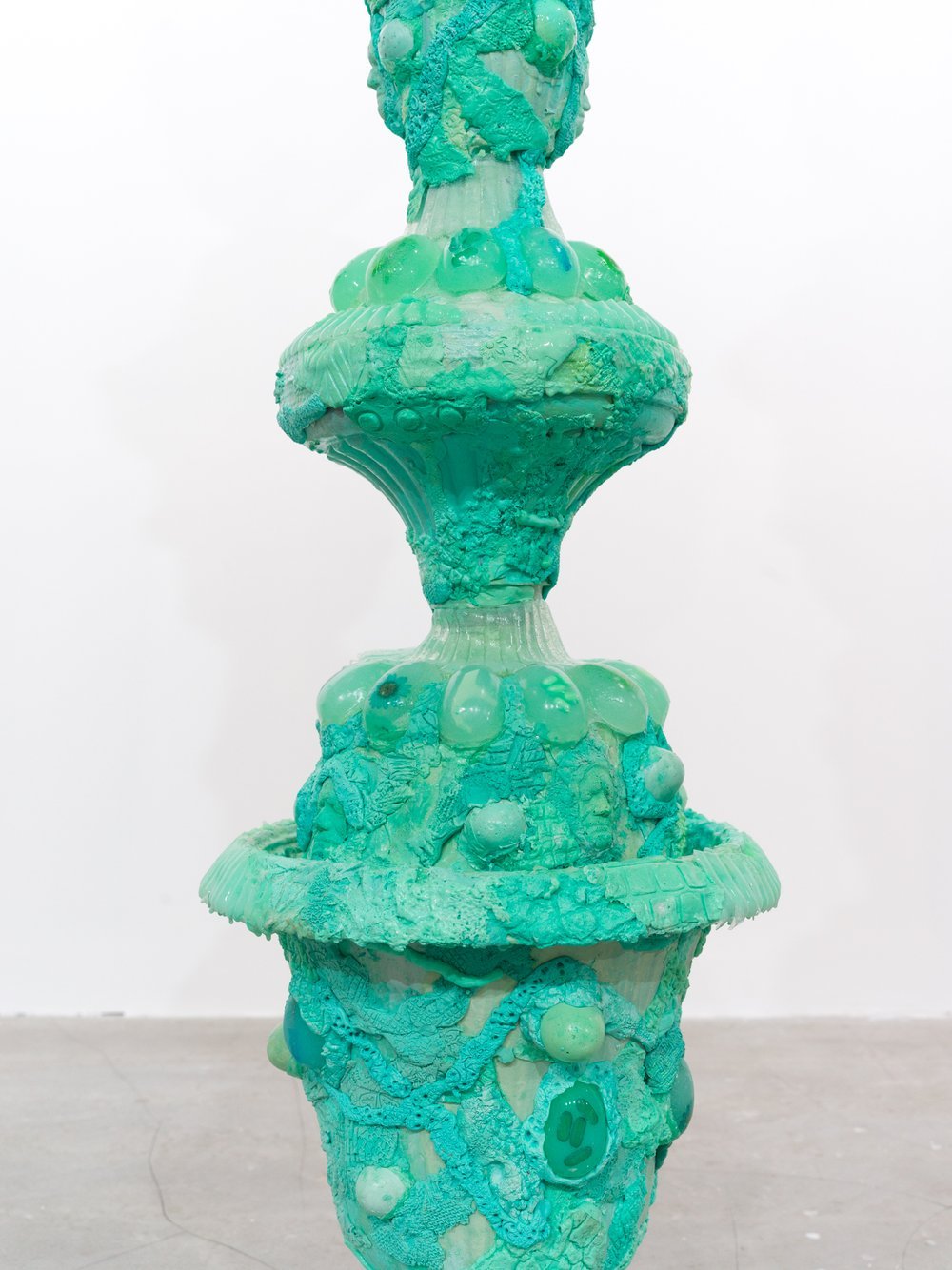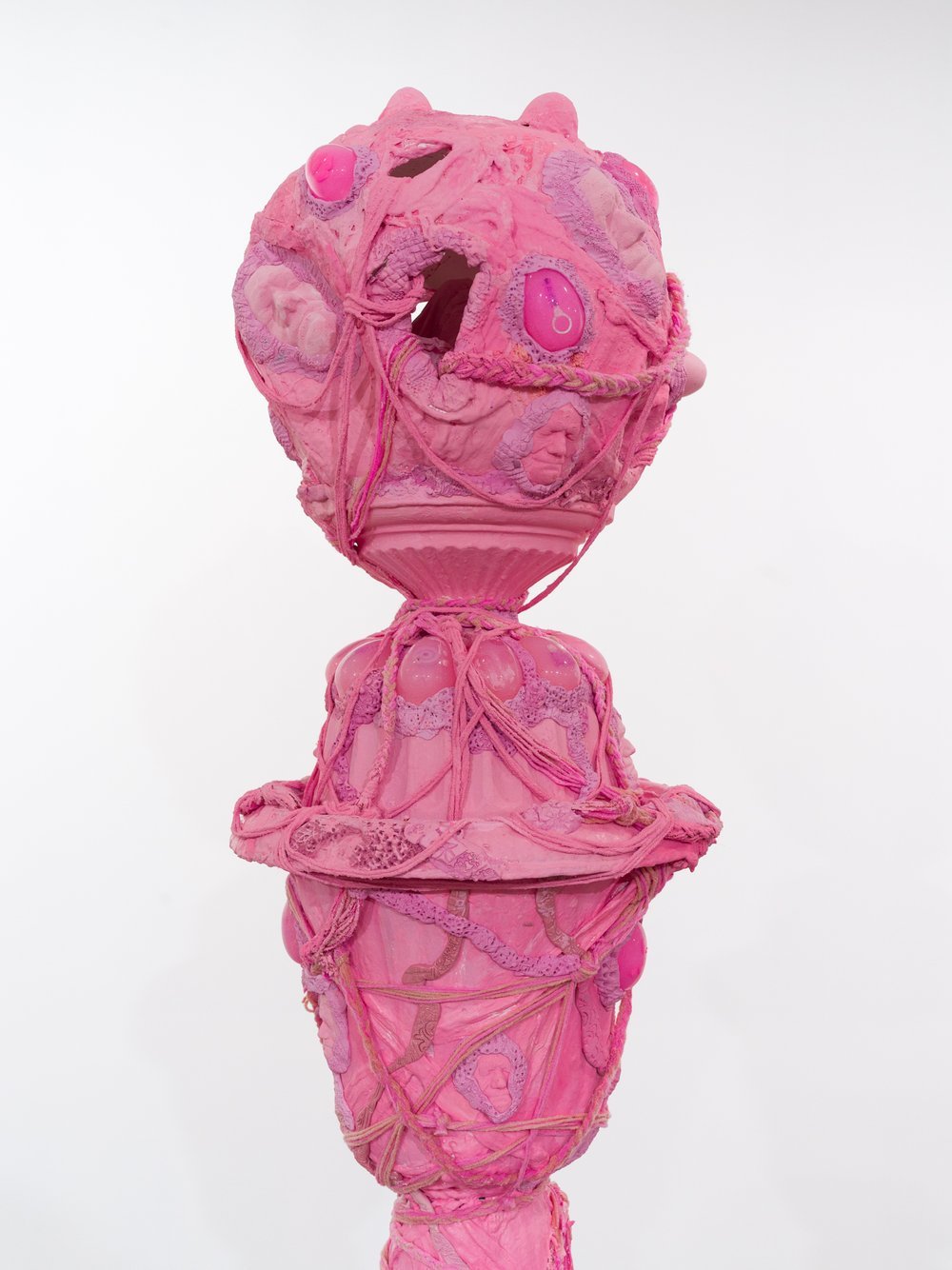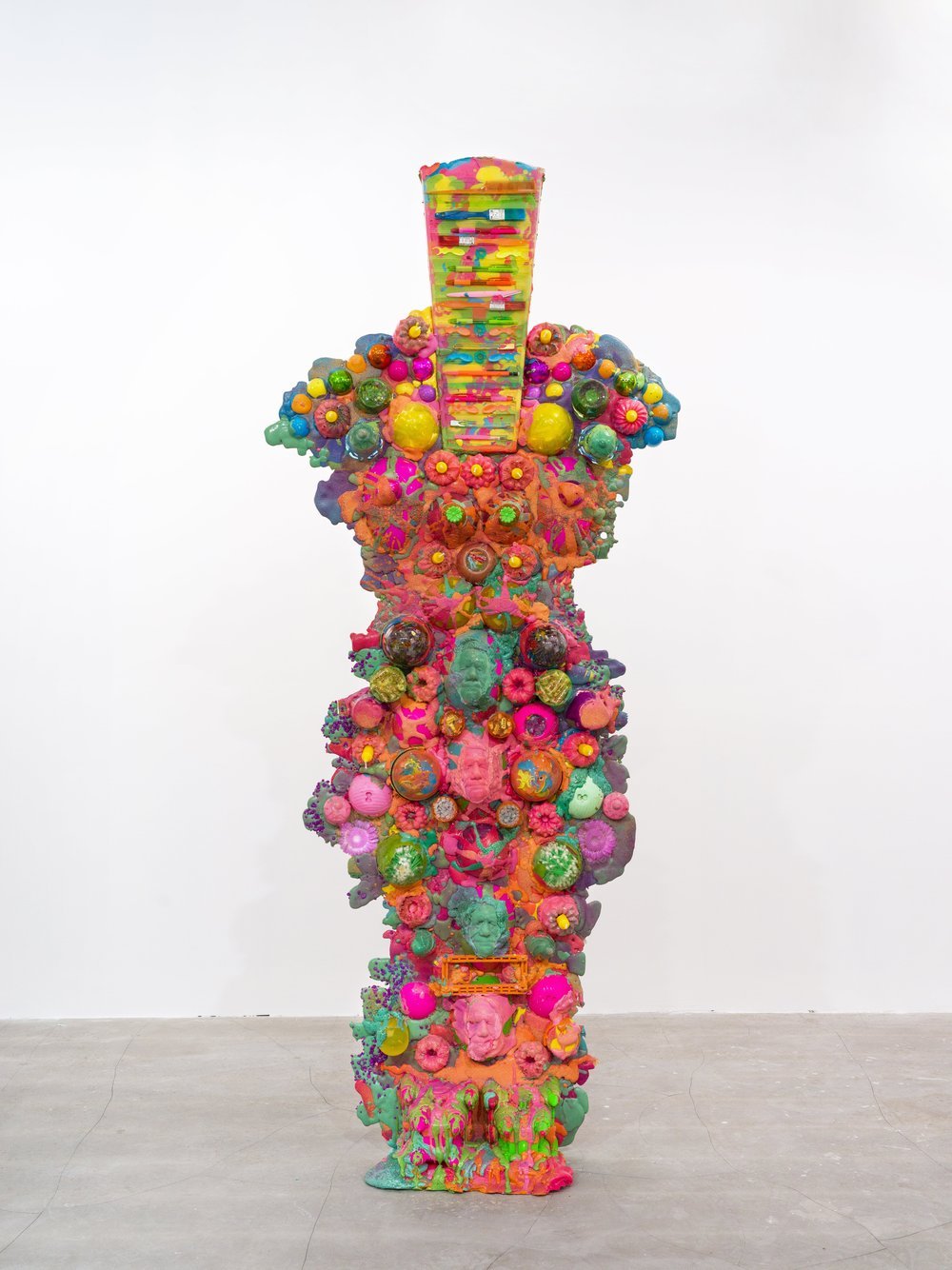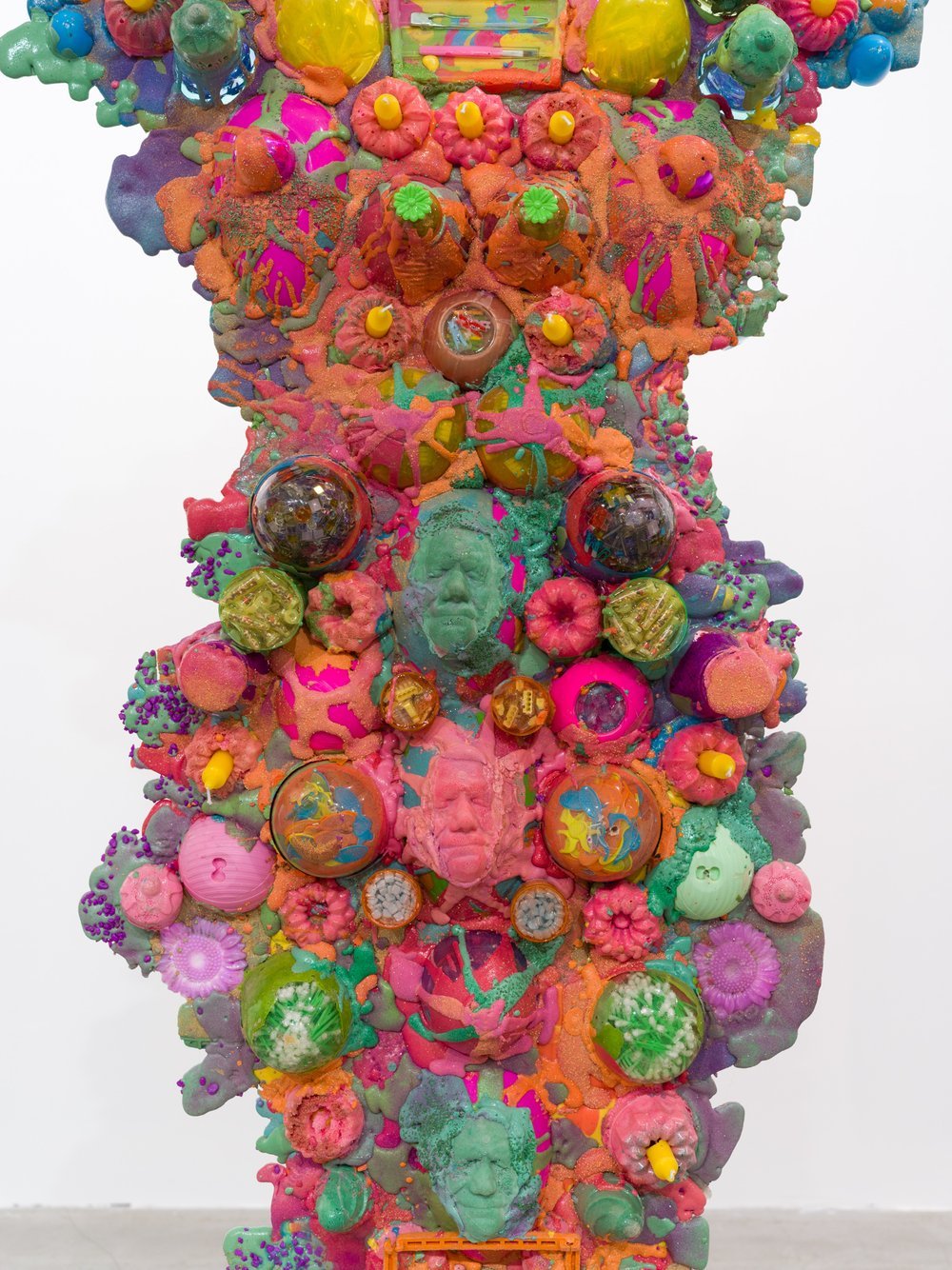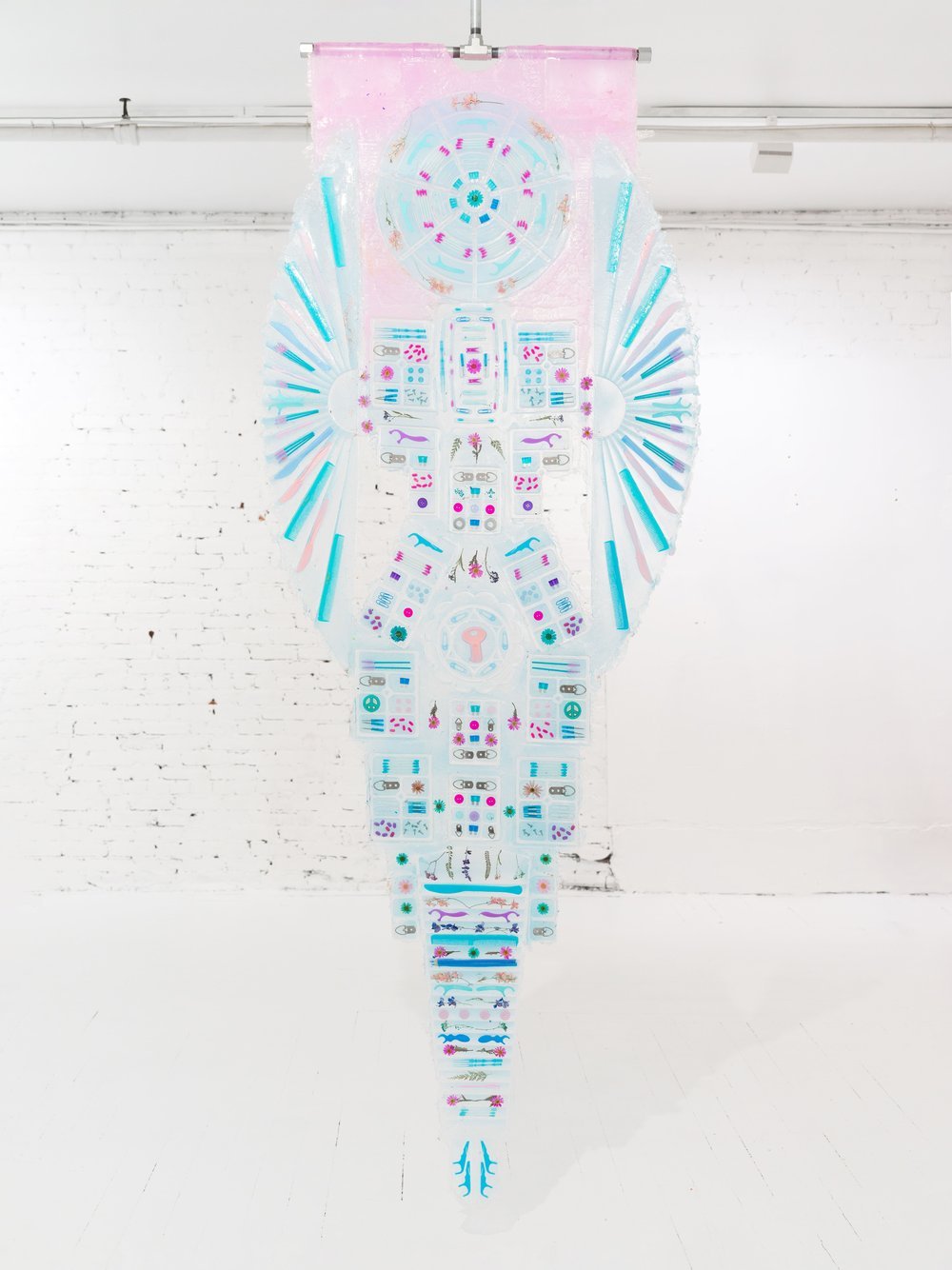Amy Brener
Pinnacles
January 14 - February 19, 2022
Vase. Orb. Diadem. Globe. Shield. Sculpture.
Handle. Bracket. Packet. Capsule. Trinket. Tread. Kit.
Amy Brener’s “Pinnacles” would suggest we had reached some summit, and from there, might have a view.
Look around, survey.
A procession of single-colored objects in double file, poised on the floor and adorning the walls—lead us to a polychrome “altar,” less stable in shape than its acolytes. Beyond, a stair to a basement; two hanging “garments” dressing this lower room. Not for us, already embodied, self-embodied, wearing themselves, disembodied, captured angels?
These sculptures, mostly titled Omni-Kits and Flexi-Shields, could be called vestments, furniture, and architectural ornaments; assembled, in efficient rows, for catalog in a museum’s decorative arts reliquary. But the aesthetic reads more Polly Pocket than Antique Roadshow. Nostalgias are conflated, and the familiar becomes strange. Egg tray wheels serve up deviled auto fuses. Cheap plastic peace signs float, as offerings, to the surface of breast-like molds. Binding braids and twists of yarn trace the edges of pierced orbs, like flotsam encrusting the shore. In Brener’s world, things glide contrary to our acculturated codes and expectations, merely passing, like a father’s blessing, for meanings we can take for granted.
Arrested in candy-colored gypsums, resins and silicones, these symmetrical, patterned, and bound forms appear to serve a devotional or memorial purpose. Yet they embody a contradiction: What we care about and how we care for it is suffused with stuff that we don’t give a shit for and that will outlast us all. Within these works is a delicate accounting of the sorts of things we wouldn’t care to tally: Flossers, screws, pills, buttons, tic-tacs and wall tacks, paper clips, disposable pens and knives; a medicine cabinet, junk drawer, 99-cent garden of knicks and knacks; treasure eggs, baking molds, floor mats, and multi-packs. In contrast, her father’s face, in miniature and at scale, eyes closed. All these objects ossify into neat rows, tapping out a code of daily ablutions. We’re not atop a mountain nor even a turreted roof, but within a kaleidoscope of daily make and making. Embedding becomes an act of turning definitions, positions, and values inside-out.
The central work, Pinnacle, is the elder, and a literal accretion. Amassed in the early lonely lock-down of the pandemic, it’s a trippy-drippy conglomerate of all the materials left in exile; a packing up, a sweeping out; the last urgent deformation made in a studio soon to be vacated; a singular friend. It sports transparent teat-like protuberances down its front, large smooth ovum stuffed with new and tiny doodads. On the contrary, the hard surface harboring these vacuoles is secreted and oozing in texture. A miniaturized mold of Brener’s late father’s face plays throughout Pinnacle’s lumpy contours—his visage, in fact, dapples all the works—replicating notions of genes and gender. Move around to the back of Pinnacle and any logic to the garish accumulation falls away. Here is the messy slough of our beloved rituals and humans. The warmth of the kitchen sink after doing the dishes. The generative mycelium that transubstantiates the mundane.
I am for an art that is combed down, that is hung from each ear, that is laid on the lips and under the eyes, that is shaved from the legs, that is brushed on the teeth, that is fixed on the thighs, that is slipped on the foot.
Brener stocks our precious Named with the inscrutable no-brand repetition of the throwaway, the won’t-last-another-day, and the never-going-to-go-away. Our reverences are tumbled, in a great racket, and polished to reflect. Shapes simultaneously holding and dispersing shapes. The most fleeting of twitches captured forever in the grooves of a beloved face.
-Gabriela Salazar
__________________________________________
1 Claus Oldenburg, I Am For… (1961).
Amy Brener Omni-Kit Star, 2021 Gypsum, fiberglass, epoxy clay, platinum silicone, pigment, miscellaneous objects 27 × 27 x 16 inches
Amy Brener Omni-Kit Sconce (tangerine), 2021 Gypsum, fiberglass, epoxy clay, urethane foam and resin, pigment, miscellaneous objects 15.5 × 13.5 x 8 inches
Amy Brener Omni-Kit Sconce (bubblegum), 2021 Gypsum, fiberglass, epoxy clay, urethane foam and resin, pigment, miscellaneous objects 16 × 13 x 8 inches
Amy Brener Omni-Kit Wall Doll (aqua), 2021 Gypsum, urethane plastic, pigment, miscellaneous objects 73.5 × 25 x 3 inches
Amy Brener Omni-Kit Wall Doll (bubblegum), 2021 Gypsum, urethane plastic, pigment, miscellaneous objects 73.5 × 25 x 3 inches
Amy Brener Omni-Kit Globe (tangerine), 2021 Gypsum, fiberglass, epoxy clay, platinum silicone, steel, pigment, yarn, miscellaneous objects 55 × 24 x 24 inches
Amy Brener Omni-Kit Globe (tangerine), 2021 Gypsum, fiberglass, epoxy clay, platinum silicone, steel, pigment, yarn, miscellaneous objects 55 × 24 x 24 inches
Amy Brener Omni-Kit Globe (grape), 2021 Gypsum, fiberglass, epoxy clay, platinum silicone, steel, pigment, yarn, miscellaneous objects 55 × 24 x 24 inches
Amy Brener Omni-Kit Globe (grape), 2021 Gypsum, fiberglass, epoxy clay, platinum silicone, steel, pigment, yarn, miscellaneous objects 55 × 24 x 24 inches
Amy Brener Omni-Kit Pinnacle (aqua), 2021 Gypsum, epoxy clay, platinum silicone, urethane foam and resin, steel, pigment, miscellaneous objects 80 x 16 x 16 inches
Amy Brener Omni-Kit Pinnacle (aqua), 2021 Gypsum, epoxy clay, platinum silicone, urethane foam and resin, steel, pigment, miscellaneous objects 80 x 16 x 16 inches
Amy Brener Omni-Kit Pinnacle (aqua), 2021 Gypsum, epoxy clay, platinum silicone, urethane foam and resin, steel, pigment, miscellaneous objects 80 x 16 x 16 inches
Amy Brener Omni-Kit Pinnacle (bubblegum), 2021 Gypsum, epoxy clay, platinum silicone, urethane foam and resin, steel, pigment, miscellaneous objects 80 x 16 x 16 inches
Amy Brener Omni-Kit Pinnacle (bubblegum), 2021 Gypsum, epoxy clay, platinum silicone, urethane foam and resin, steel, pigment, miscellaneous objects 80 x 16 x 16 inches
Amy Brener Omni-Kit Pinnacle (bubblegum), 2021 Gypsum, epoxy clay, platinum silicone, urethane foam and resin, steel, pigment, miscellaneous objects 80 x 16 x 16 inches
Amy Brener Pinnacle, 2020 Urethane resin and foam, pigment, wood, miscellaneous objects 78 x 30 x 10 inches
Amy Brener Pinnacle, 2020 Urethane resin and foam, pigment, wood, miscellaneous objects 78 x 30 x 10 inches
Amy Brener Pinnacle, 2020 Urethane resin and foam, pigment, wood, miscellaneous objects 78 x 30 x 10 inches
Amy Brener Pinnacle, 2020 Urethane resin and foam, pigment, wood, miscellaneous objects 78 x 30 x 10 inches
Amy Brener Pinnacle, 2020 Urethane resin and foam, pigment, wood, miscellaneous objects 78 x 30 x 10 inches
Amy Brener Flexi-Shield Harbinger (ice), 2021 Platinum silicone, pigment, flowers, miscellaneous objects 96 x 36 x 2 inches
Amy Brener Flexi-Shield Harbinger (ice), 2021 Platinum silicone, pigment, flowers, miscellaneous objects 96 x 36 x 2 inches
Amy Brener Flexi-Shield Harbinger (rose), 2021 Platinum silicone, pigment, flowers, miscellaneous objects 96 x 36 x 2 inches
Amy Brener Flexi-Shield Harbinger (rose), 2021 Platinum silicone, pigment, flowers, miscellaneous objects 96 x 36 x 2 inches

